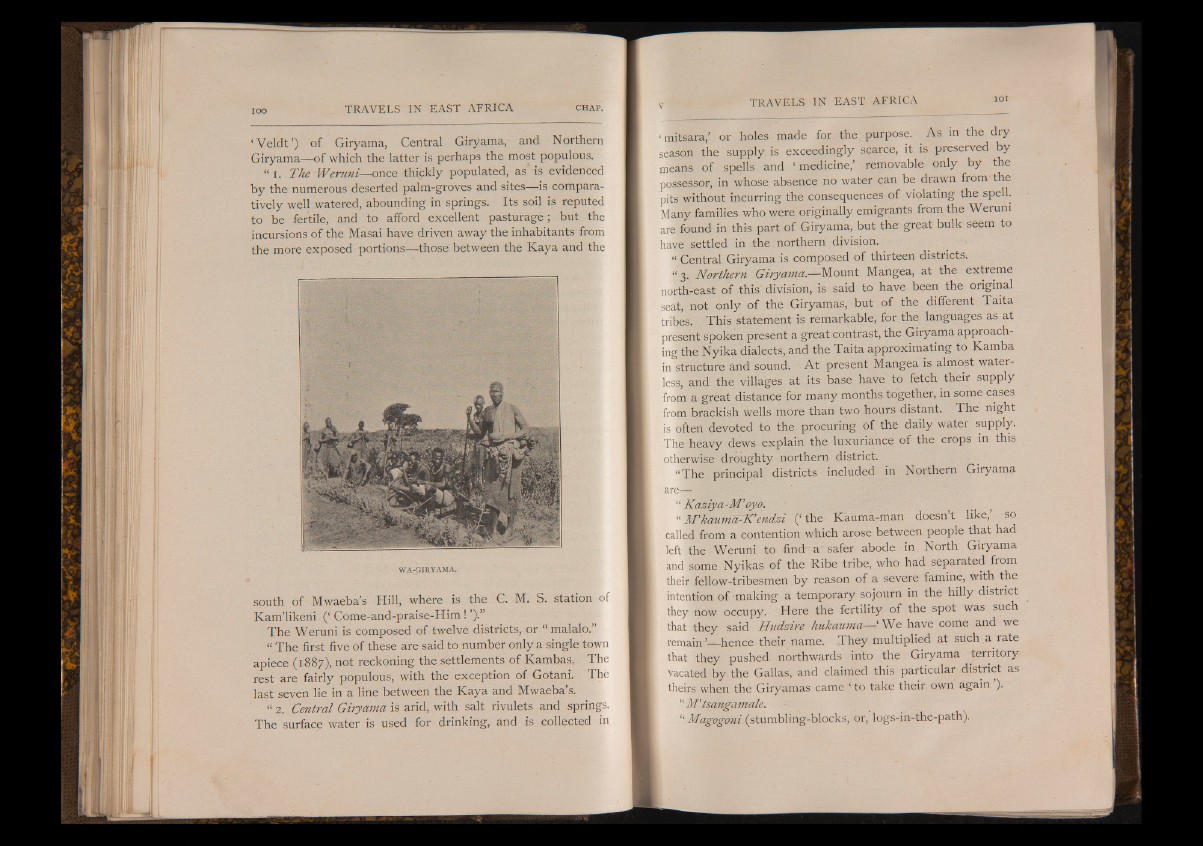
loo TRAVELS IN EAST AFRICA CHAP.
‘ Veldt1) of Giryama, Central Giryama, and Northern
Giryama— of which the latter is perhaps the most populous.
“ I. The Weruni— once thickly populated, as is evidenced
by the numerous deserted palm-groves and sites— is comparatively
well watered, abounding in springs. Its soil is reputed
to be fertile, and to afford excellent pasturage; but the
incursions of the Masai have driven away the inhabitants from
the more exposed portions— those between the Kaya and the
W A -G IR Y AM A .
south of Mwaeba’s Hill, where is the C. M. S. station of
Kam’likeni (‘ Come-and-praise-Him I1).11
The Weruni is composed of twelve districts, or I malalo.”
“ The first five of these are said to number only a single town
apiece (1887), not reckoning the settlements of Kambas. The
rest are fairly populous, with the exception of Gotani. The
last seven lie in a line between the Kaya and Mwaeba s.
“ 2. Central Giryama is arid, with salt rivulets and springs.
The surface water is used for drinking, and is collected in.
t r a v e l s in e a s t a f r i c a
< mitsara,1 or holes made for the purpose. \ As in the dry
season the supply is exceedingly scarce, it is preserved by
means of spells and ‘ medicine,1 removable only by the
possessor, in whose absence no water can be drawn from the
pits without incurring the consequences of violating the spell.
Many families who were originally emigrants from the Weruni
are found in this part of Giryama, but the great bulk seem to
have settled in the northern division.
“ Central Giryama is composed of thirteen districts.
“ 3. Northern Giryama.— Mount Mangea, at the extreme
north-east of this division, is said to have been the original
seat, not only of the Giryamas, but of the different Taita
tribes. This statement is remarkable, for the languages as at
present spoken present a great contrast, the Giryama approaching
the Nyika dialects, and the Taita approximating to Kamba
in structure and sound. - A t present Mangea is almost waterless,
and the villages at its base have to fetch their supply
from a great distance for many months together, in some cases
from brackish wells more than two hours distant. The night
is often devoted to the procuring of the daily water supply.
The heavy dews explain the luxuriance of the crops in this
otherwise droughty northern district.
“The principal districts included in Northern Giryama
are
“ Kaziya-M'oyo. - ' _
“ M'kauma-K'endzi (‘ the Kauma-man doesn’t like, so
called from a contention which arose between people that had
left the Weruni to find-a*'safer abode-in North Giryama
and some Nyikas of the Ribe tribe, who had separated from
their fellow-tribesmen by reason of a severe famine, with the
intention of making a temporary sojourn in the hilly district
they now occupy. Here the fertility of the spot was such
that they said Hudzire hukauma— ‘ We have come and we
remain1— hence their name. They multiplied at such a rate
that they pushed northwards into the Giryama territory
vacated by the' Gallas, and claimed this particular district as
theirs when the Giryamas came ‘ to take their own again ).
“ M’tsangamale.
“ Magogoni (stumbling-blocks, or, logs-in-the-path).